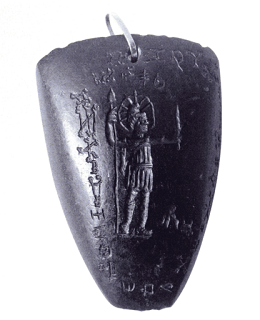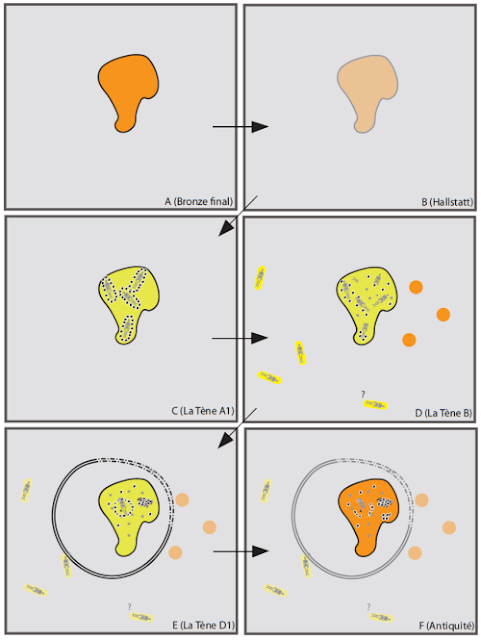If anything, archaeologists are much annoyed by messed up chronologies. There are always some “intrusive finds”, “residual artefacts” or “stray objects” that need to be sorted out and removed from the analysis. Archaeological layers almost invariably include small quantities of objects from previous periods that came there either accidentally, for instance when people would dig pits or till the soil, or as “collateral damage” of archaeological excavation and post-excavation work. It is one of archaeologist’s fundamental tasks to clear up this mess and to sort out associations of finds and other excavated features (pits, walls, floors etc.) that are broadly contemporary. What we all dream of are neat sequences of archaeological contexts that would line up on temporal scale one after another: settlement phases clearly separated by layers of total destruction, graveyards developing concentrically from the oldest interments in the centre to the most recent on the outer fringe and, more generally, historical periods characterised by exclusive, easily distinguishable types of objects.
So it happens that at some point our cleansing zeal may turn into chronological puritanism. Our subject matter is indeed regularly sliced up in chronological phases, to which archaeological objects somehow “belong”. The most important work is to assign objects to adequate time-slices, normally the periods of their production/manufacture. Archaeological phases would, then, become associations of objects which were produced contemporaneously and which “belong together” by virtue of chronological mapping. But what about all those objects which clearly do not belong to chronological contexts in which they participate, for instance, medieval churches in modern towns or old works of art in museums? Such objects unavoidable for understanding the functional/cultural contexts through which they remained present.
Holistic or purified approach – the choice is, actually, not that hard for an archaeologist. Our subject matter and our training are invariably organised according to temporal ranges. A medieval archaeologist, a prehistorian. But what is the glue which binds these chronological periods together? Note that the key for chronology is not necessarily the function but the origin, the temporal coordinate which is intrinsic to each and every archaeological object. Time thus becomes indistinguishable from the identity of objects, and chronological phases become meta-objects because they describe a unity on a genealogical level. One is permitted to discuss, say, the Iron Age or Early Dynastic not as an intersection of various historical processes, each with its own dynamics, but rather as a closed system composed of static objects (one object – one date). That is rather convenient, indeed, as one can be a specialist of the Early Iron Age without much knowledge of the Bronze Age or a specialist of the Early Dynastic period without much interest in the Pre-Dynastic. What is more, many social models that archaeologists use were developed for the contemporary society (19th – 20th century) and are not historical. This applies to landscape archaeology in particular because of its reliance on geographical concepts such as the central place model or site catchment.
In order to arrive at “historical dynamics,” we need to establish recurring patterns, continuities and discontinuities between already defined and analysed chronological phases. However, this “dynamics” is a secondary phenomenon because the culture itself is entirely contained in time-slices which archaeologist study. Culture is what happens in a time span of, say, 100 or 200 years at maximum, especially if culture is understood as social organisation, i.e. a set of contemporary relationships. In other words, the past becomes something non-cultural, it is an invisible hand of a socio-environmental system which exists beyond human comprehension. It may seem closer to natural phenomena, forces and objects simply existing out there and wielding their innate power.
In sum, anachronic objects are very annoying, but the problem is not in objects themselves, it is rather in the chronological puritanism. We may “identify” objects by single dates, but their identity in much more complex, much more biographical – and so is the identity of landscapes. A stone axe could have been made in the Neolithic, but it could also have been part of a much later cultural landscape. Romans, for instance, were well aware of stone axes and interpreted them as materialisations of thunder (thunderstones). Archaeologists, however, when stumbling upon such anachronistic association (Roman – Neolithic) usually proclaim that these are a kind of “natural objects”, i.e. curiosities that were interpreted according to contemporary (Roman) systems of meaning – which would then justify the act of purification. Neolithic is not Roman, the object-date paradigm claims. Romans could not have had any notion of Neolithic, they simply (mis)interpreted objects that existed out there. Crucially, this interpretation is entirely Roman, developed within the Roman culture, it is unrelated to the prehistoric Neolithic period and it cannot be an expression of a genuine awareness of such a deep time – but why not?
The problem which now emerges is how deep could historical awareness penetrate in time and how should we call it, i.e. how should we conceptualise it: as cultural memory, tradition or history? I use here the term historicity, which normally signifies the authenticity of a historical event or a person. In relation to our problem, historicity would be the quality of “pastness” of an object, a quality that emerges at the intersection between object’s intrinsic, non-cultural properties and its subsequent interpretation. It is crucial that this quality is, partly at least, a property of the object itself. For instance, the Neolithic axes became an element of Roman culture because they are found in relatively large numbers and because they somehow resemble actual artefacts, but could not be directly compared to anything in contemporary use.
 |
| Neolithic axehead with engraved figure of Saturn and inscriptions in Greek alphabet (Faraone 2014, fig 6; originally from Theocharis 1973, pl. 240) |
Nevertheless, small artefacts are generally problematic for the study of “deep” historicity because they are normally removed from their original context and inserted into much later one (which is why they capture our attention in the first place). They can usually be explained away as collected curiosities, unless some obvious patterns would appear, such as systematic appearance in graves ([as documented in Scandinavia][1], for example). A very interesting article has recently been published on the reuse of Neolithic axes in the Roman period (Faraone 2014). Upon closer scrutiny, it can be said that the reuse of these prehistoric artefacts in the form of protective amulets was a generalised practice (*ibid*).
However, even in the case of Roman amulets, the actual relationship to past periods would be difficult to understand: general folklore, religious beliefs or reference to more concrete historical events? Reuse of ancient remains in the landscape is a much safer path to examine because, theoretically at least, the choice of a particular site could be related to a particular historicity it carries. For instance, a choice of an ancient site for a necropolis is more likely to be related to particular, site-specific stories, even when these stories belong to an established genre or pattern, such as “Attila’s tomb” that can be found in many places in Europe.
Ancient sites that are well documented in terms of reuse in later periods typically feature monumental or otherwise massive constructions, such as megalithic structures of large earthworks. The problem is that these are impressive features in the landscape which have their own, physical impact in the landscape – such sites have to be interpreted somehow, one cannot pretend a large megalithic monument didn’t exist. In other words, their historicity may be unrelated to the actual history of the place itself, but rather to general folklore attributed to such places. The same would be true for remains of large habitats, featuring earthworks, terraces and such. What we would need are sequences of more subtle traces, traces that are not important in themselves but whose overlapping rather testify to the importance of the place itself. A number of such examples can be found in the volume entitled “Memory Myth and Long-term Landscape Inhabitation”, edited by A. Chadwick and C. Gibson (2013), but let me turn to a case from my study area in France.
 |
| Villemanoche pit (green) (from Chevrier 2012, fig 3). |
Rescue excavations in Villemanoche near the Seine – Yonne confluent revealed a strange site, rather difficult to characterise. First, in the Bronze Age, a large pit was excavated, presumably for extraction of clay. Such pits are quite typical for the region and can be found on many Bronze and Iron Age sites. Then, possibly some 400 years later, at the beginning of the Late Iron Age, the same pit was reused as a cemetery. Many strange things happened afterwards, including a burial of a horse and a deer with pieces of harness, construction of a circular ditch around the pit and finally possible quarrying for building material in the Roman period. More details can be found in a quite comprehensive article by S. Chevrier *et al *(2012). What is interesting for the problem of the historicity of landscape features is that a humble pit, apparently not different from other similar pits in the region, survived in the local memory for several centuries before developing into some kind of “special place”. Of course, the area was inhabited during this time span and the site could have been frequented from time to time. However, these activities did not leave a detectable trace and must have been rather ephemeral. The reuse of the site for cemetery must have been guided by a memory of the place because its presence in the landscape would have been very discrete (a shallow depression at best). This was not a reuse of a ready-made monument such as a megalith or a grave mound.
Perhaps claiming that a place such as Villemanoche pit could have persisted in local memory for several centuries is not such a revolutionary idea, after all, much deeper time can be discerned in place-names and folk stories in contemporary Europe. However, the corollary to this idea that previous periods were not present in the landscape only as a collection of material traces, but also through a genuine awareness of the past, that the “pastness” actually defined some places as such, often seems particularly hard to swallow for archaeologists. This would imply that one cannot study successfully Iron Age graveyards without taking into account what happened and what was remembered from previous periods, including such mundane things as large pits. Worse still, the regional distribution and the appearance of Iron Age graveyards might be closely related to the presence/absence of earlier traces (or even activities without a trace) in the landscape – which would imply that pure historicity becomes a significant factor for understanding the Iron Age. But who would want to go that road?
Notes
[1]: http://www.heritagedaily.com/2011/10/the-thunderstone-mystery/12981
Bibliography:
A. Chadwick and C. Gibson (eds.) (2013): Memory, Myth and Long-Term Landscape Inhabitation, Oxbow Books.
S. Chevrier in collaboration with C. Fossurier, D. Lalaï and J. Wiethold (2014): Des animaux et des hommes inhumés dans une fosse à Villemanoche (Yonne) : un cas particulier de pratiques funéraires au second âge du fer dans le Sénonais. In I. Bede and M. Detante (eds.): Rencontre autour de l’animal en contexte funéraire, Actes de la Rencontre de Saint-Germain-en-Laye des 30 et 31 mars 2012*. [see on academia.edu]
Ch. Faraone 2014. Inscribed Greek Thunderstones as House- and Body-Amulets in Roman Imperial Times, Kernos 27/2014, 257-284. Available online since October 2016 on http://kernos.revues.org/2283.
